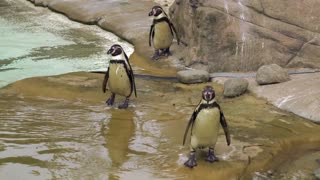Premium Only Content

CUTE PENGUINS
A penguin’s feathers serve to regulate body temperature, increase aerodynamic efficiency underwater, and defend against the elements. Beyond providing insulation, feathers can also minimize drag by trapping bubbles against their body and then releasing them during a dive. A diving penguin emits a visible trail of bubbles as it moves through the water. Penguins take great care of their feathers, often preening three hours a day. An oil secreting gland, the uropygial gland, lies at the base of a penguin’s tail and dispenses water-repelling and microbial deterring oil that a penguin then physically spreads over its body.
Most bird’s feathers are arranged in parallel tracks, but this distribution leaves featherless gaps. Penguin feathers by comparison are continuously spaced across the penguin’s skin. Until recently it was believed that penguins had the highest feather density of all birds, revealed emperor penguin feather density averaged around 9 feathers per centimeter, less than a fourth of what was previously believed. In addition to the contour feathers that line the birds entire body and help give it shape, penguins also have after-feathers (fluffy, downy bits that cling to the contour feathers), plumules (down feathers that attach to the skin), and filoplumes (microscopic feathers with barbs on the end). The individual function of each feather type is still unclear, but plumules are nearly four times more numerous than contour feathers, leading scientists to believe they serve an important purpose.
Considering penguins live at varying latitudes it should follow that different species exhibit variations in their feathers. All penguins maintain a body temperature between 100 and 102 degrees Fahrenheit (around 38°C) but they live in temperatures that range from 90 degrees Fahrenheit (32°C) along the coast of Patagonia to negative 76 degrees Fahrenheit (-60°C) on the sea ice of Antarctica. Feathers account for nearly 85 percent of a bird’s insulation, and when the weather is warm that insulation can make temperatures a bit toasty. The banded penguins, such as the Humboldt and African penguins, have featherless patches on their faces and feet where they divert blood to cool when overheated. In contrast, the Adélie penguin, one of two Antarctic species, has complete feather coverage up to the base of its beak.
Although feathers can be fluffed up or flattened down, penguins also use other methods to keep their temperatures at the right level. When an Adélie penguin overheats it diverts blood to its thin wings, causing the white undersides to turn a faint pink color. When cold, penguins rely on countercurrent exchange to warm up, a specific heat transferring mechanism that exchanges heat from warm blood traveling in vessels towards their legs and feet to colder blood leaving the area. Penguins need to see clearly both on land and underwater. Terrestrial animals, including humans, rely on the cornea—the clear outer layer of the eye—to focus images using a property called refraction, a bending of light as it crosses through different materials. As light travels through the air and enters the eye, it bends to the appropriate angle and creates a focused image on the retina. Underwater, terrestrial animals become far-sighted because the fluid of the eye and the water are too similar, so the light doesn’t bend enough and the image doesn’t focus effectively. Penguins solve this problem with a flattened cornea and highly modified lens. Their flattened corneas have less refractive power than those of terrestrial animals, enabling them to see clearly underwater. Their spherical lenses can compensate for the flatter cornea by also bending the light.
The king penguin’s eyes are unique even among penguins. When fully constricted the pupil appears as a pin-sized square but in low light conditions it will expand an amazing 300 fold—the greatest change in pupil size of any bird—to increase light reception. This is especially important when king penguins dive to their greatest depths, around 984 feet (300 meters). The contrast in light is equivalent to bright sunlight and starlight. Because maximum foraging depths can be reached in five minutes, there isn’t enough time for the retina to adapt to the changing light. By constricting the pupil to a pinhole in sunlight the retina is pre-exposed to the lower ambient light levels found at maximum dive depths where the pupil then fully expands.
Adapted to underwater conditions, penguins have shifted their visual light spectrum in favor of violet, blue, and green and to exclude red, a color that quickly disappears at depths greater than 10 feet (3 meters). It is thought that penguins can even see ultraviolet light—emperor and king penguin beaks reflect ultraviolet rays, the only marine birds to do so. The display of ultraviolet could contribute to mate selection with both females and males preferring mates with stronger displays of ultraviolet reflectance.
HEARING
Like other birds, penguin ears lack external ear flaps. The ears reside on either side of the head as holes covered by feathers. As any SCUBA diver knows, pressure changes from diving can damage the fragile structures within the ear. A study of the king penguin ear showed that their middle ear is protected from pressure changes during diving by a special organ made of cavernous tissue. When ambient pressure increases the tissue expands into the middle ear to maintain a constant pressure.
In the cacophony of hundreds of penguins on land a returning parent can pin point their chick from the rest of the colony based on its unique call. One study of African penguins found their hearing range to be between 100 and 15,000 Hz, but peak sensitivities were between 600 and 4,000 Hz—in comparison, humans hear between 20 and 20,000 Hz.
An acute sensitivity to sound may be a defense penguins employ in the face of predators like orcas and leopard seals. One study showed even when asleep, king penguins could distinguish between predatory sounds and harmless sounds. In the presence of an orca call penguins flee upon awakening. Similar to migratory birds, penguins may rest only one half of their brain while the other stays vigilant, constantly monitoring the surroundings for possible threats.
TASTE
Penguins have poor taste reception, similar to most birds. A recent study showed penguins lack the sweet, bitter and umami taste receptor genes, maintaining only salt and sour. Most birds only lack sweet. It is believed that the cold temperatures of Antarctica, where modern penguins evolved, contributed to the loss of these tastes as sweet, umami and bitter taste receptors function poorly in cold temperatures. Penguins also lack taste buds on their tongue, leading scientists to question whether penguins can taste at all.
SMELL
The olfactory lobe in the brains of penguins is relatively large. Historically it was believed that penguins possessed a rudimentary sense of smell but recent studies indicate smell may play a larger role in a penguin’s life than previously thought. Studies of African, Humboldt and chinstrap penguins indicate some penguins can detect prey using olfactory cues such as chemicals released by foraging krill. The Humboldt penguin uses smell to distinguish between related and unrelated individuals and to find mates.
The largest of the penguins, the emperor, stands at just over four feet tall while the smallest, the little penguin, has a maximum height of a foot. (Smithsonian Institution)
Penguins claim their own family, the Spheniscidae family, and are likely most closely related to other birds like the petrel and albatross. There is still debate over the number of distinct species, but it is generally agreed that there are between 17 and 19 species (see rockhopper and little penguin sections for more information). The species are divided among six genus divisions, or genera, commonly referred to as the crested, banded, brush-tailed, large, yellow-eyed, and little.
1. Crested Group (Eudyptes)
Macaroni (Eudyptes chrysolophus)- Macaroni penguins are the most abundant of all the penguins. The most southerly distributed crested penguin, they live along the coasts of sub-Antarctic islands and the Antarctic Peninsula. The lifespan of a Macaroni penguin spans from 8 to 15 years. Macaroni prefer krill but will also eat small fish and squid. They are roughly 27.5 inches (70 cm) in height and between 8 to 14 pounds (3.7-6.4 kg) in weight.
Royal (Eudyptes schlegeli)- The royal penguin differs from other crested penguins in its orange plumage instead of yellow and white face. Some still argue that it is a white-faced variant of the Macaroni penguin due to genetic similarities but others point to distinct ecological differences and breeding isolation. Breeding is restricted to Macquerie Island off New Zealand and begins in October. Chicks take 35 days to hatch and become reproductively mature themselves after 5 to 6 years. Individuals can live between 15 and 20 years. They mostly eat krill but supplement their diet with small fish. Royal penguins stand at 28 inches (70 cm) and 8.8-12 pounds (4-5.5 kg).
Fiordland (Eudyptes pachyrhynchus)– Fiordland penguins have the characteristic yellow tufts of feathers like other crested penguins and live along the temperate rainforests of South Island and Stewart Island of New Zealand. Unlike many penguin species, they prefer to nest isolated from other mating couples. The birds nest under forest canopy, in caves, under boulders and shrubbery, and in nests made of brush and grass. They eat fish larvae, crustaceans and squid. Breeding season begins mid-winter in July and egg incubation ranges between 4 and 6 weeks. Adults stand 22 inches (55 cm) at between 5.5 and 10.75 pounds (2.5-4.9 cm) and live to be up to 20 years old.
Rockhopper (Eudyptes chrysocome)- The rockhopper penguin is further divided into three subspecies, the Northern, Southern and Eastern rockhoppers, and is the source for much of the debate surrounding the total number of penguin species. They live on small, isolated islands in the sub-Antarctic regions of the Atlantic and Indian oceans. Rockhopper nesting grounds are on rugged terrain requiring the penguins to hop from rock to rock, the inspiration for their name. The birds can congregate in colonies containing up to 100,000 individuals. Breeding season begins in October, eggs are laid by November and chicks hatch 33 days later. The average rockhopper lives 10 years, but they may live as long as 30 years. They feed on krill, small fish and squid. Rockhopper penguins are the only species to jump feet first into the water when they dive. They stand at 18 inches (46 cm) and weigh 5 to 10 pounds (2.2 to 4.5 kg).
Snares Crested (Eudyptes robustus)-Snares crested penguins live on the isolated and densely forested Snares Islands, a group of small islands roughly 60 miles (100 km) south of New Zealand. They inhabit the most restricted area out of all the penguins and eat squid and small fish. The birds breed under the protection of the Olearia forests in nests of peat, pebbles, and brush beginning in September. Two eggs are laid a few days apart and hatch between 31 and 37 days later. Snares crested penguins reach sexual maturity at age 6 and may live up to their early 20s. They stand at 22 inches (56 cm) and weigh between 6 and 10 pounds (2.7 to 4.5 kg)
Erect-crested (Eudyptes sclateri)- The erect-crested penguins are best identified by their upright and fanned yellow plumes. Colonies exist on the islands off New Zealand including Bounty and Antipodes Islands. Male competition for breeding sites in September is fierce and penguins commonly resort to biting and beating each other with flippers. The diet of erect-crested penguins is not well known, though it is suspected they eat krill, small fish, and squid like other crested penguins. They stand at 26 inches (67 cm), weigh up to 14 pounds (6.4 kg) and live up to 15 to 20 years.
2. Banded Group (Spheniscus)
Humboldt (Spheniscus humboldti)- Native to the hot climate of the Atacama Desert on the coast of South America, Humboldt penguins have large, bare skin patches around their eyes, an adaptation to help keep them cool. Humboldt penguins dig nests in sand or penguin poop (guano) where they incubate the eggs for 40 to 42 days. Breeding season is either March to April or September to October depending on the location of the colony. Humboldt penguins rely on the nutrient rich Humboldt Current to support the anchovy and sardine populations they prey upon. The Humboldt is one of the most popular zoo penguins due to its ability to withstand warmer climates. They stand at an average height of 25.5 inches (65 cm) and weigh between 8 and 13 pounds (3.6-5.8 kg). Magellanic (Spheniscus magellanicus)- The Magellanic penguin lives along the southern coast of South America from Argentina on the Atlantic side to Chile in the Pacific. Their breast plumage consists of two black stripes that differentiate them from the geographically nearby Humboldt penguin. Magellanic penguins nest in ground dugouts, when possible, or under brush. Both parents share sitting on the egg for the 39 to 42 day incubation period. During the winter months, between May and August, Magellanic penguins migrate along the coast of Chile, and as far north as Brazil on the East Coast, chasing anchovies. Adults stand at 28 inches (70 cm) and weigh up to roughly 15 pounds (6.5 kg).
African (Spheniscus demersus)- The African penguin is sometimes referred to as the jackass penguin for its shrill braying that sounds like a donkey. They inhabit the southern shores of Africa from Namibia to South Africa and feed on pilchard, sardines, anchovies, and mackerel. Their nesting colonies are large and noisy. Each breeding couple lays two eggs in a shallow dugout in the ground. Eggs are incubated between 38 to 40 days by both parents. They have a lifespan between 10 and 15 years. At 23 to 25 inches tall (58-63.5 cm) and weighing between 5 and 9 pounds (2-4 kg) they are one of the smaller penguins.
Galapagos (Spheniscus mendiculus)- Galapagos penguins are the most northerly penguins, living along the Galapagos Islands on the equator. These penguins have special adaptations and behaviors that help them deal with the tropical heat. Galapagos penguins actively seek out shade, pant, stand with wings spread, and hunch over on land to shade their feet, an area of heat loss. Galapagos penguin breeding is completely dependent upon the Cromwell Current and they may breed during any month of the year depending upon seasonal climate conditions. When the Cromwell Current fails to upwell and bring colder, nutrient rich water to the surface, penguins delay breeding presumably because of low food availability. The highly variable climate is influenced by the unpredictable El Niño Southern Oscillation (ENSO). Once the penguins are able to breed, egg incubation is roughly 40 days. The Galapagos are the smallest of the banded penguins at 21 inches (53 cm) and weigh up to 5.5 pounds (2.5 kg).
3. Brush-tailed Group (Pygoscelis)
Chinstrap (Pygoscelis antarcticus)- Chinstrap penguins are distinguishable by their white face and a thin black band that runs across the chin. Unlike many other penguin species, the chinstrap usually rears both chicks to adulthood when environmental conditions are favorable. They nest on the Antarctic Peninsula and sub-Antarctic Islands in the South Atlantic on rocky terrain. Beginning in November, adults incubate the eggs in shallow pebble nests for up to five to six weeks. They prey upon Antarctic krill, Euphasia supurba, almost exclusively but will also eat small fish. At a maximum size of 30 inches (76) and weighing 10 pounds (4.5 kg), they are medium-sized penguins.
Gentoo (Pygoscelis papua)- The largest of the brush-tailed penguins, this bird is further distinguished by its red beak. The gentoo nests on both the Antarctic Peninsula and on sub-Antarctic islands. They construct nests with tussock grass and moss when available but will also use pebbles in rockier environments. Both eggs are incubated for 31 to 39 days. Loyal birds, they not only return to the same nesting site every year but will also form lasting bonds with breeding partners. Adults subsist on mostly Antarctic krill but will also eat other crustaceans, squid, and fish. Gentoo penguins reach sizes up to 32 inches (81 cm) and 15 pounds (6.5 kg).
Adélie (Pygoscelis adeliae)- The Adélie penguin is one of two penguins to nest exclusively on Antarctic shores, the only other penguin to do so is the formidable emperor penguin. An ice-dependent species, they rely on the ice for foraging, often trapping prey under ice floes (sheets of ice that jigsaw the ocean surface) and resting on top of them to avoid predators. Populations are on the decline on the northern Antarctic Peninsula, where air temperatures significantly increased in the latter half of the 20th century due to climate change. Breeding season begins in October, with eggs hatching after 35 days of incubation. They rely heavily on Antarctic krill but also eat fish, crustaceans, and other krill species. The birds stand at 27 inches (70 cm) and weigh up to 12 pounds (6.5 kg).
4. Large Group (Aptenodytes)
Emperor (Aptenodytes forsteri)- Living exclusively within the Antarctic, emperor penguins are truly animals fit for the extreme. To enable chicks the best chance of survival, adults incubate the egg in subzero conditions (some days hit -40 degrees Fahrenheit/Celsius) during the dead of winter. Breeding season begins at the end of March with couples congregating in one of 45 different colonies along the Antarctic sheet ice. After a quick courtship, females lay a single egg and transfer it to a nest between the feet of the father. The egg will sit on the father’s feet for roughly two months while the mother returns to the sea to feed on fish, krill, and squid. Father emperors battle harsh temperature and wind conditions while incubating the egg. They often lose as much as half their body weight during the process. At a maximum size of 51 inches (130 cm) and 88 pounds (40 kg) they are the largest penguin species.
King (Aptenodytes patagonicus)- Lasting between 14 to 15 months, the king penguin’s breeding cycle is the longest of any bird. Adult couples can only afford to raise two chicks every three years because of the extensive time needed to rear one chick. Breeding may begin anywhere from November to April so colonies have a mix of chicks of various ages. King penguins breed on sub-Antarctic islands within the Southern Atlantic. Standing they can reach heights up to 38 inches (95 cm) with weights as high as 35 pounds (16 kg).
5. Yellow-Eyed (Megadyptes antipodes)-
Yellow-eyed penguins are the most private of all penguins, preferring to nest out of sight from other penguins. They often forgo parental duties if they are within eyesight of other nesting couples. For this reason they often nest among the tree trunks of the dwarf rata forests on the islands off of New Zealand where they are native. The breeding season is particularly long, lasting from August to February. Egg incubation alone can take up to two months. They weigh between 5 and 5.5 pounds (2.3-2.5 kg) and reach heights of 65 cm (25 inches).
6. Little Penguins (Eudyptula)
Little or Fairy (Eudyptula minor) – The smallest of the penguins, the little penguin claims the rocky island coasts around New Zealand and Australia as home. Colonies are usually at the base of sandy dunes or cliffs. They eat mostly small fish, but occasionally will consume krill and small squid. Little penguins live an average of 6.5 years though they have been known to reach ages as high as 20. Breeding season begins in August and lasts until December. Chicks take roughly 36 days to hatch and then another 3 to 4 weeks where they depend on their parents for food. Juveniles reach sexual maturity at age three. They weigh in at a mere 2 to 3 pounds (.9-1.4 kg), and stand only 12 inches (24 cm) tall.
THANKS FOR WATCHING THIS VISEO.
-
 0:19
0:19
pitallesco
3 years agoCUTE PENGUINS GO FOR A SWIM
23 -
 0:30
0:30
Animals and birds
4 years agoPenguins so cute
97 -
 LIVE
LIVE
Spartan (Pro Halo esports Player)
41 minutes agoScrims vs Optic at 4 EST, SWTOR after
45 watching -
 13:07
13:07
Bearing
7 hours agoJoe Biden’s Cognitive Decline on FULL DISPLAY 🤪 “An Insurrection .. I started ” ⁉️
29.5K59 -
 LIVE
LIVE
GamerGril
28 minutes ago☠ Doom Gal ☠ | Tonight We Dine In Hell | Doom The Dark Ages
68 watching -
 5:23
5:23
Talk Nerdy Sports - The Ultimate Sports Betting Podcast
2 hours ago🎯 8 Bets Sharper Than a Sunday Fade – May 18 Picks with Vas
3.2K2 -
 LIVE
LIVE
DragoRSA
6 hours ago🎭 Trilogy Time! Mass Effect 1–3 with YOUR Choices! 💬
36 watching -
 37:19
37:19
Athlete & Artist Show
21 hours ago $3.87 earnedZach Boychuk Says Farewell To Berlin, World Championships Experience, NHL Draft and MORE!
39.3K6 -
 LIVE
LIVE
TwinGatz
4 hours ago🔴LIVE - It's All So Tiresome | DOOM: The Dark Ages
317 watching -
 8:14
8:14
The Art of Improvement
3 days ago10 Difficult Skills that Pay Off Forever
31K6